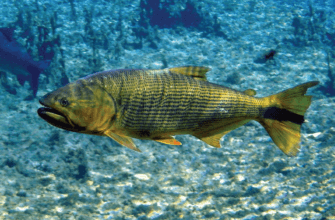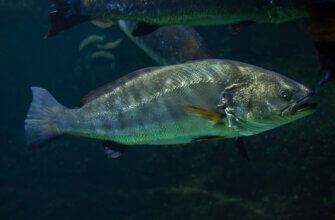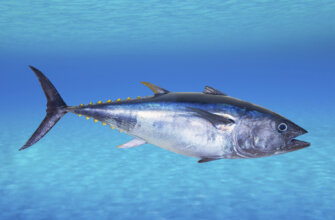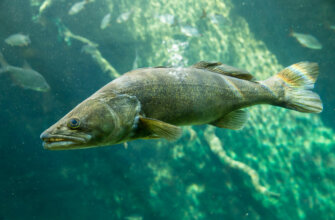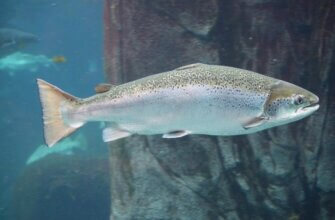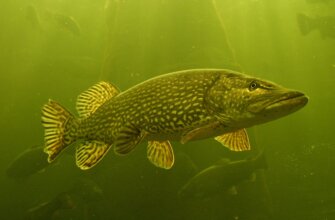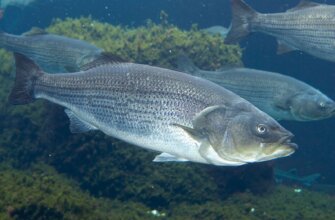Redfish, also known as red drum, is a saltwater fish species that is commonly found in the western Atlantic Ocean, Gulf of Mexico, and southern Atlantic coast of the United States. It is prized for its firm white meat and is a popular game fish for recreational anglers.
Redfish typically have a reddish-bronze color on their backs, with a silver-white belly. They have a single, elongated spot on their tails, which is one of their distinguishing characteristics. Redfish can grow to be quite large, with some specimens reaching over 50 inches in length and weighing over 50 pounds.
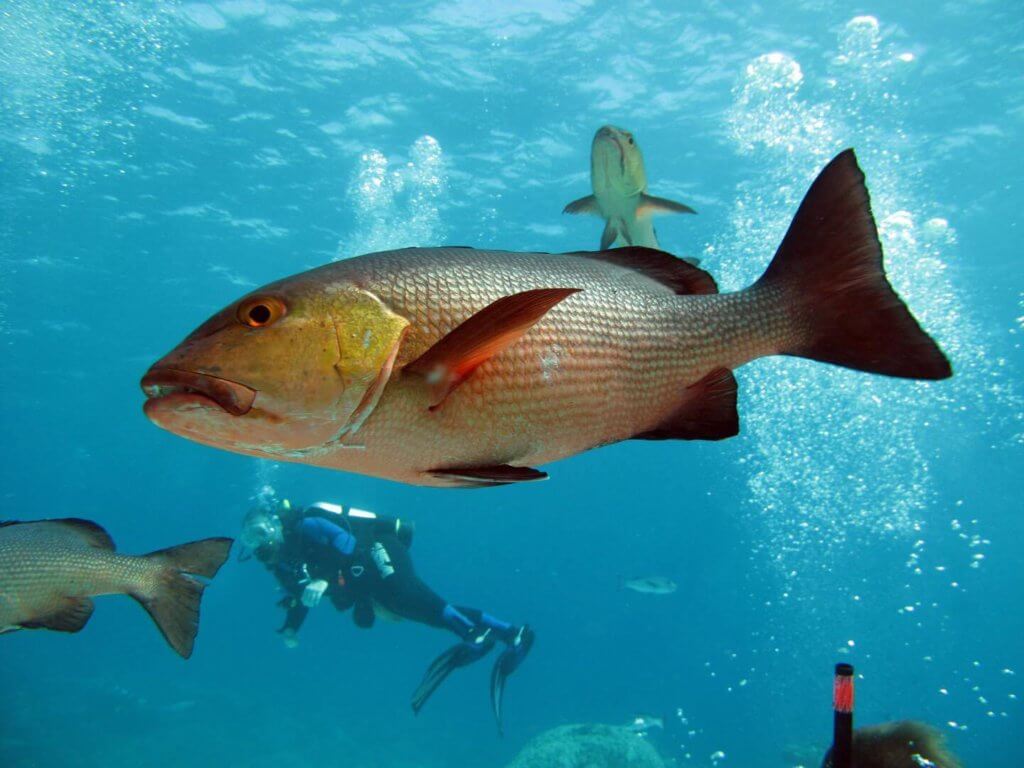
Redfish are bottom feeders and consume a variety of prey, including crustaceans, mollusks, and smaller fish. They are commonly caught using live or cut bait, as well as artificial lures. Redfish are also farmed commercially, particularly in Asia, and are a popular food fish in many parts of the world.
Due to overfishing in some areas, redfish populations have declined in recent years, and some fisheries have implemented conservation measures to protect the species.
Species
Redfish can refer to several different species of fish depending on the region and context.
Here are a few examples:
- Redfish or Red Drum (Sciaenops ocellatus). This is a popular game fish found in the Atlantic Ocean and Gulf of Mexico, particularly in the southeastern United States. It gets its name from its reddish-copper color and the “drumming” sound it makes by vibrating its swim bladder. Redfish can grow up to 60 inches in length and weigh up to 90 pounds.
- Redfish or Ocean Perch (Sebastes spp.). This is a group of fish found in the North Atlantic and North Pacific oceans. They are typically deep red in color and have spiny fins. Ocean Perch are a popular food fish and can live up to 50 years.
- Redfish or Red Gurnard (Chelidonichthys kumu). This is a species of fish found in the waters around New Zealand and southern Australia. It is also known as the “New Zealand Gurnard” or “Kumu.” Red Gurnard have distinctive, fan-like pectoral fins that they use to “walk” along the seafloor. They are a popular food fish in New Zealand.
Each of these species has unique physical and behavioral characteristics, as well as different culinary uses and conservation status.
Appearance
As mentioned before, the appearance of a redfish can vary depending on the species.
Here are some general physical characteristics of the Red Drum or Sciaenops ocellatus:
- the body of a Red Drum is typically reddish-copper in color on the top and fades to a silvery-white color on the belly;
- they have a black spot on their tail fin that looks like an eye, which is where their species name “ocellatus” comes from (meaning “eye-spotted” in Latin);
- red Drum have a pointed head, a large mouth, and a single row of small teeth;
- they have a strong, muscular body with a tapered tail and a dorsal fin that runs most of the length of their back.
Ocean Perch or Sebastes spp. have a different appearance:
- they are typically deep red in color, with some species having black spots on their sides;
- they have spiny fins and a stout, heavy body.
Red Gurnard or Chelidonichthys kumu have the following appearance:
- they have a reddish-brown body with a pale underbelly;
- their most distinctive feature is their large, fan-like pectoral fins, which they use to “walk” along the seafloor.
Size and weight
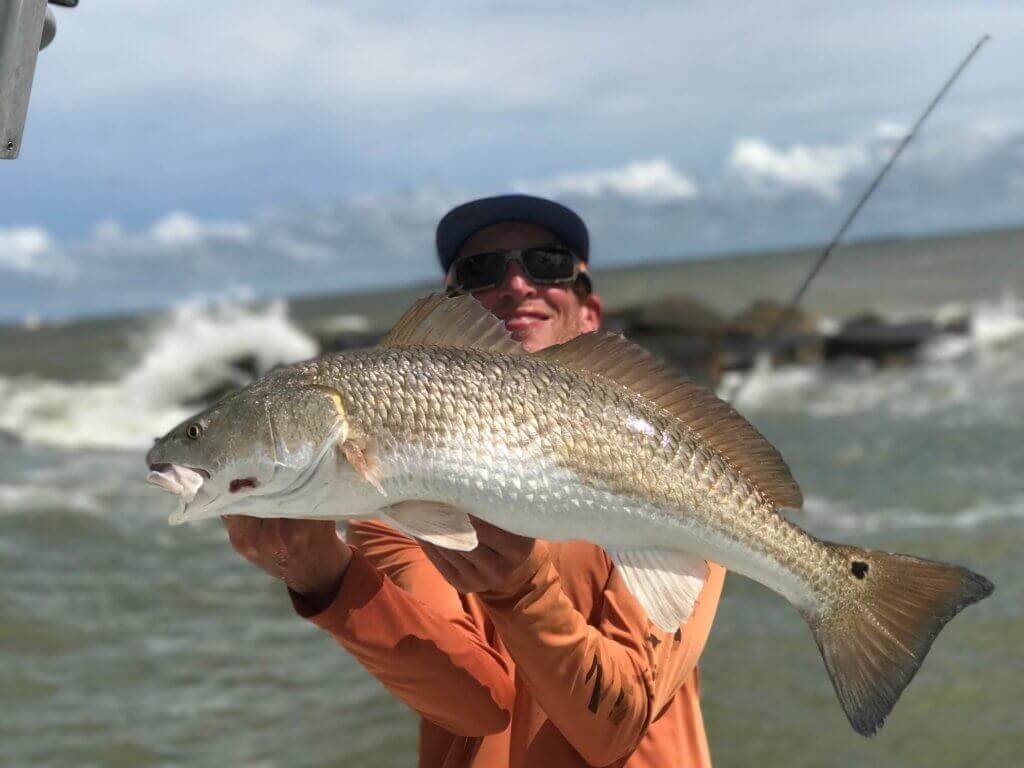
The size and weight of a redfish can vary depending on the species.
Here are some general size and weight ranges for the three examples mentioned earlier:
- Red Drum or Sciaenops ocellatus: Adults can grow up to 60 inches in length and weigh up to 90 pounds, although most are between 18 and 40 inches long.
- Ocean Perch or Sebastes spp.: Depending on the species, they can grow up to 20 inches in length and weigh up to 4 pounds.
- Red Gurnard or Chelidonichthys kumu: They can grow up to 15 inches in length and weigh up to 1 pound.
It’s worth noting that size and weight can also vary depending on factors such as age, sex, and diet, among others. Additionally, fishing regulations may limit the size and/or number of redfish that can be harvested.
Diet
Redfish, also known as red drum, is a popular fish species that is found in coastal waters of the Atlantic Ocean and Gulf of Mexico. It is known for its reddish color and distinctive black spot near the base of its tail. Redfish has a mild, sweet flavor and a firm, flaky texture, making it a versatile fish for cooking.
When it comes to the diet of redfish, they are opportunistic predators that feed on a variety of prey depending on their size and habitat. Juvenile redfish primarily feed on small crustaceans, such as shrimp and crabs, as well as small fish like mullet and menhaden. As they grow larger, their diet may include larger crustaceans, such as blue crabs and mud crabs, and a wider variety of fish, such as pinfish, croakers, and mullet. Redfish are also known to feed on small marine worms, insects, and even small mollusks.
Redfish typically forage near the bottom of the water column, using their excellent sense of smell and sight to locate prey. They are known to feed in marshes, estuaries, seagrass beds, and near oyster reefs, where they can find an abundance of food.
It’s worth noting that the diet of redfish can vary depending on their geographic location, season, and availability of prey. Redfish are also known to exhibit some degree of dietary selectivity, preferring certain types of prey over others.
In terms of human consumption, redfish is considered a good source of protein, omega-3 fatty acids, and other essential nutrients. It is a popular target for recreational fishing and is also commercially harvested. When consuming redfish or any other fish, it’s important to follow local fishing regulations, guidelines for sustainable fishing practices, and be mindful of potential contaminants, such as mercury, in fish from certain areas.
Behavior
Redfish, also known as red drum or Sciaenops ocellatus, are a popular game fish found along the coasts of the Atlantic Ocean and Gulf of Mexico in North America. They are known for their striking reddish-bronze coloration, which gives them their name, and their powerful, hard-fighting behavior when hooked.
Here are some key details about the behavior of redfish:
- Feeding behavior. Redfish are opportunistic predators that feed on a wide variety of prey, including fish, crustaceans, and mollusks. They are known to forage in a variety of habitats, such as marshes, estuaries, and nearshore waters. Redfish use their strong senses of sight and smell to locate food, and they often feed aggressively, especially during periods of low light or tidal changes.
- Social behavior. Redfish are known to form schools, especially when they are juveniles. These schools can consist of dozens to hundreds of fish and may provide protection from predators and increase their chances of finding food. As redfish grow larger, they tend to become more solitary and may be found in smaller groups or even alone.
- Habitat preferences. Redfish are typically found in shallow, coastal waters, although they can also be found in deeper waters. They prefer a variety of habitats, including marshes, seagrass beds, oyster reefs, and tidal creeks. They are well-adapted to brackish or saltwater environments and can tolerate a wide range of salinity levels.
- Spawning behavior. Redfish have a unique spawning behavior where they produce drumming sounds using their swim bladder during courtship and mating. They typically spawn in nearshore or offshore waters during the late summer or early fall, with females releasing thousands of eggs that are fertilized by males. Redfish are known for their relatively slow growth rate and can take several years to reach sexual maturity.
- Seasonal behavior. Redfish are known to exhibit seasonal movement patterns. In colder months, they may move into deeper waters or seek out warmer areas, while in warmer months, they may move into shallower waters to feed and spawn. They are also known to be more active during certain tidal phases and may adjust their feeding behavior accordingly.
- Territorial behavior. Redfish can exhibit territorial behavior, especially when it comes to defending their feeding or spawning grounds. They may aggressively defend their preferred habitats from intruders, including other redfish or other species.
- Catch-and-release behavior. Redfish are a popular sport fish and are often caught and released by anglers. When caught, they can display strong, spirited fights, often using their powerful tails to make powerful runs. It is important to handle redfish with care when practicing catch-and-release, ensuring that they are properly revived before being released to maximize their chances of survival.
Overall, redfish are known for their opportunistic feeding behavior, seasonal movement patterns, and territorial tendencies. They are a prized game fish among anglers for their fighting ability and beautiful coloration, making them a popular target for recreational fishing in coastal waters.
Spawning
Redfish spawning behavior can vary depending on the species.
Here are some general examples of redfish spawning behavior:
- Red Drum or Sciaenops ocellatus. They spawn offshore in nearshore waters from late summer to early fall, with peak spawning occurring in September and October. Males will make a drumming sound during the spawning season to attract females. Females can produce millions of eggs, which hatch into larvae that spend their first few months in estuarine environments before migrating to deeper waters.
- Ocean Perch or Sebastes spp. Most species of Ocean Perch spawn in the winter or spring in deep offshore waters, with the larvae drifting to shallower waters after hatching. Some species may migrate to specific spawning grounds each year.
- Red Gurnard or Chelidonichthys kumu. They spawn from late winter to early summer, with peak spawning occurring in spring. They typically spawn in shallow water close to shore. Females can produce up to 300,000 eggs, which hatch into larvae that drift with the current before settling to the bottom.
It’s worth noting that the spawning behavior of a redfish can also be influenced by factors such as water temperature, lunar cycles, and availability of food. Additionally, some species may have specific behaviors related to their breeding or migration patterns, such as the formation of large spawning aggregations.
Fishing
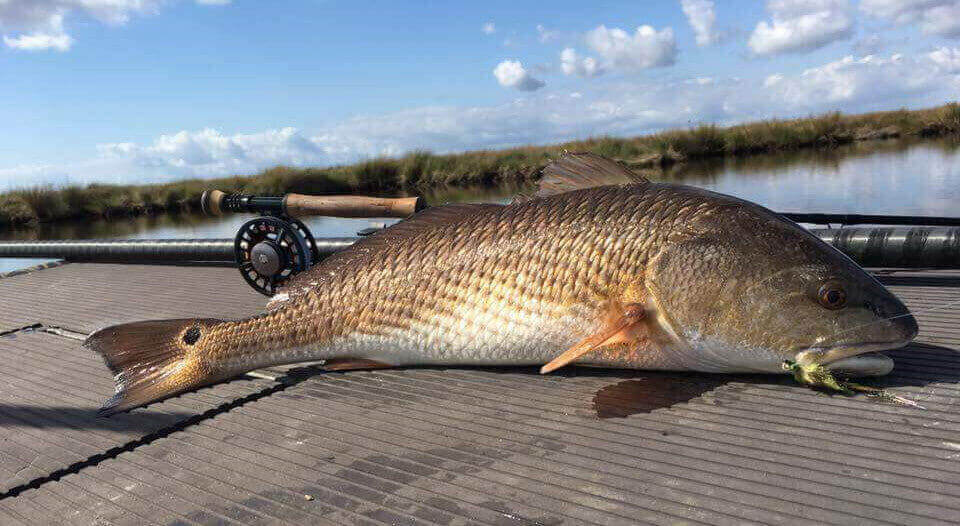
Redfish, also known as red drum or simply “reds,” are popular game fish found in coastal waters of the Atlantic Ocean and Gulf of Mexico in the United States. They are known for their reddish-bronze coloration, large size, and strong fighting ability, making them a sought-after target for recreational anglers.
Here are some details about fishing for redfish:
- Habitat. Redfish are typically found in shallow coastal waters, including marshes, estuaries, bays, and flats. They prefer areas with structure such as oyster beds, grass beds, and mangroves, as well as channels and drop-offs where they can ambush prey.
- Tackle. When targeting redfish, anglers typically use medium to heavy spinning or baitcasting tackle with a strong, sensitive rod and a reel spooled with braided or monofilament line. Redfish have a reputation for putting up a strong fight, so a stout rod and reel combo is essential to handle their power.
- Baits and Lures. Redfish are opportunistic predators that feed on a variety of prey, including shrimp, crabs, mullet, and other small fish. Popular baits for redfish include live or cut bait such as shrimp, mullet, or menhaden. Artificial lures such as soft plastics, spoons, and topwater plugs can also be effective, particularly when targeting redfish in shallow water.
- Techniques. There are several techniques that can be effective when fishing for redfish. These include:
- Sight Fishing. Redfish often feed in shallow water and can be spotted cruising or tailing in the shallows. Sight fishing involves visually locating redfish and casting lures or baits in their path, requiring stealthy approach and accurate casting.
- Bottom Fishing. Redfish are bottom feeders and can be caught using bottom fishing techniques. This involves casting or dropping baits to the bottom and waiting for redfish to locate and strike the bait.
- Casting to Structure. Redfish are known to hang around structure such as oyster beds, grass beds, and mangroves. Casting lures or baits close to these structures and retrieving them with an enticing action can attract redfish to strike.
- Drifting. Drifting with the current or wind can be an effective way to locate redfish. Anglers can use live or cut bait, or artificial lures, and drift along likely redfish areas, covering a larger area in search of active fish.
- Regulations. It’s important to check the local fishing regulations and adhere to catch limits, size limits, and any other fishing regulations for redfish in the area where you are fishing. Redfish populations are managed to ensure their sustainability, and it’s important to practice responsible angling by following all regulations and practicing catch-and-release whenever possible.
Remember to always practice ethical angling by handling fish with care, releasing undersized or over-the-limit fish, and respecting the environment. Fishing for redfish can provide an exciting and rewarding angling experience, and following local fishing regulations helps to protect their populations for future generations to enjoy.
Lures
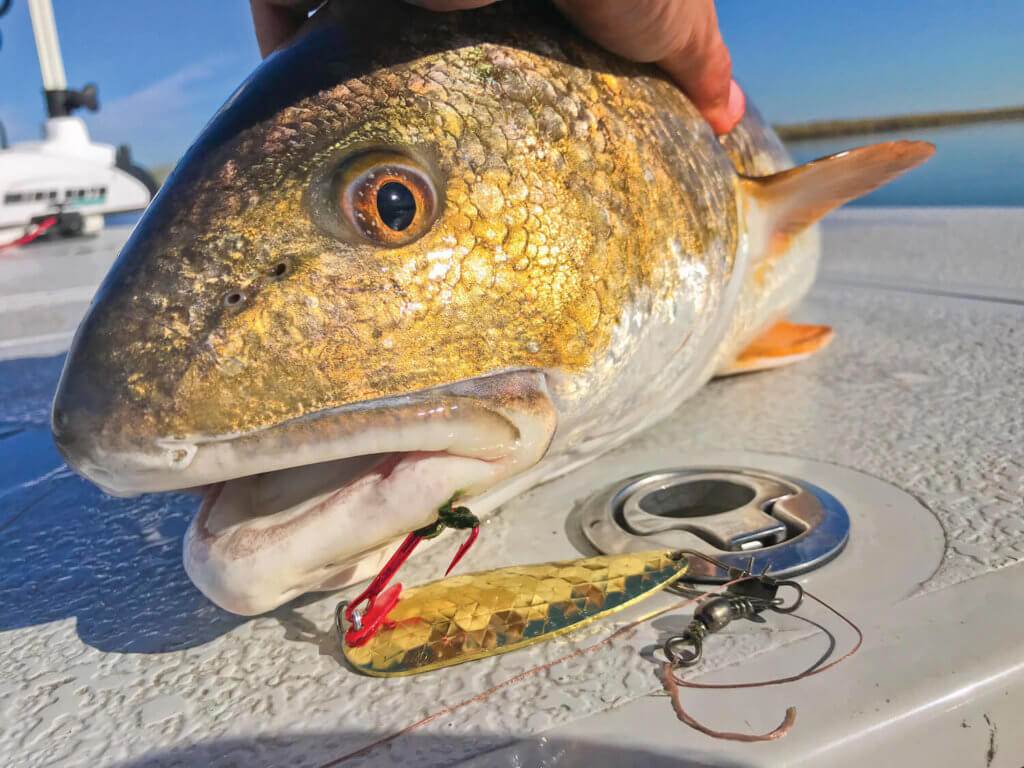
Redfish can be caught using a variety of lures, with the choice of lure depending on the species and the fishing conditions.
Here are some examples of lures that are commonly used to catch redfish:
- Soft plastic baits. These are versatile lures that can be rigged weedless or with a jighead. They can be fished slowly along the bottom or worked more quickly through the water column. Soft plastic baits are often used to imitate shrimp, mullet, or other prey that redfish feed on.
- Spoons. These are metal lures that can be cast and retrieved or trolled. They are effective at imitating small baitfish or crustaceans and can be fished at a variety of depths.
- Topwater lures. These lures are designed to be worked on the surface of the water, creating a commotion that can attract redfish. They are often used in shallow waters or near structure such as grass beds or oyster bars.
- Crankbaits. These are hard-bodied lures that can be cast or trolled. They are effective at imitating baitfish and can be fished at a variety of depths.
It’s worth noting that the choice of lure can also be influenced by factors such as water temperature, water clarity, and the type of habitat where redfish are found. Additionally, some species may have specific feeding preferences or behaviors that can be targeted with certain types of lures. As always, it’s important to follow fishing regulations and best practices to ensure the sustainability of redfish populations.
Sure, here are some examples of popular fishing lures for redfish, along with their models and specifications:
- Gulp! Saltwater Swimming Mullet: This soft plastic bait is designed to imitate a mullet and can be rigged weedless or with a jighead. It comes in a variety of colors and sizes, such as 3″ or 4″.
- Johnson Silver Minnow Spoon: This metal spoon lure can be cast and retrieved or trolled, and is effective at imitating small baitfish. It comes in a variety of sizes, such as 1/4 oz or 1/2 oz.
- Heddon Super Spook Topwater Lure: This topwater lure is designed to create a commotion on the surface of the water and attract redfish. It comes in a variety of colors and sizes, such as 5″ or 7″.
- Rapala X-Rap Saltwater Fishing Lure: This hard-bodied lure can be cast or trolled and is effective at imitating baitfish. It comes in a variety of colors and sizes, such as 4″ or 5″.
- Z-Man Scented PaddlerZ Soft Plastic Paddle Tail Swimbait: This soft plastic bait features a paddle tail that creates a swimming motion in the water. It can be rigged weedless or with a jighead and is scented to attract fish. It comes in a variety of colors and sizes, such as 4″ or 5″.
It’s worth noting that the size, color, and type of lure that works best for redfish can vary depending on the fishing conditions and the preferences of the fish. Additionally, it’s important to match the size of the lure to the size of the fish you are targeting, as using too large or too small of a lure can reduce your chances of success.
Baits
Redfish can be caught using a variety of baits, with the choice of bait depending on the species and the fishing conditions.
Here are some examples of baits that are commonly used to catch redfish:
- Live bait. Live bait is often used to catch redfish, with shrimp and mullet being popular choices. Live bait can be fished using a variety of methods, such as free-lining, under a bobber, or on a bottom rig.
- Cut bait. Cut bait, such as mullet or menhaden, can be an effective bait for redfish. Cut bait is often used when fishing in areas with a lot of current or when fishing for larger fish.
- Crab. Blue crabs or fiddler crabs can be an effective bait for redfish, especially when fishing in areas with a lot of structure or in shallow waters.
- Artificial baits. Artificial baits, such as scented soft plastic baits, can be an effective alternative to live or cut bait. They can be rigged weedless or with a jighead and fished along the bottom or worked more quickly through the water column.
It’s worth noting that the choice of bait can also be influenced by factors such as water temperature, water clarity, and the type of habitat where redfish are found. Additionally, some species may have specific feeding preferences or behaviors that can be targeted with certain types of bait. As always, it’s important to follow fishing regulations and best practices to ensure the sustainability of redfish populations.
Rods
Choosing the right fishing rod for redfish can greatly affect your chances of success when fishing for these species.
Here are some factors to consider when choosing a fishing rod for redfish:
- Length. A good length for a redfish rod is between 7 and 8 feet. This length is ideal for casting and provides enough leverage to fight larger redfish.
- Power. A medium-heavy or heavy power rod is recommended for redfish. This will allow you to handle larger fish and provide enough power to set the hook.
- Action. A fast or medium-fast action rod is recommended for redfish. This will allow you to feel the bite and set the hook quickly.
- Material. Graphite or composite rods are a good choice for redfish as they are strong and sensitive, making it easier to detect bites and set the hook.
- Handle. A comfortable handle is important when fishing for redfish, as you may be casting and fighting fish for extended periods of time. Cork or EVA foam handles are popular choices as they provide a good grip and are comfortable to hold.
- Reel seat. Look for a reel seat that is durable and fits your reel properly.
Here are a few examples of popular fishing rods for Redfish with their models and specifications:
- St. Croix Tidemaster Inshore Casting Rod: This rod is made with high-quality SCII graphite and features a fast action and medium-heavy power. It has a comfortable cork handle and a durable reel seat. Length options range from 6’6″ to 7’6″.
- Fenwick HMG Inshore Casting Rod: This rod is made with a blend of graphite and carbon fiber, providing both sensitivity and strength. It has a fast action and medium-heavy power, making it suitable for Redfish. It features a comfortable cork handle and a durable reel seat. Length options range from 6’6″ to 7’6″.
- G. Loomis E6X Inshore Casting Rod: This rod is made with high-quality materials and features a fast action and medium-heavy power. It has a comfortable cork handle and a durable reel seat. Length options range from 6’6″ to 7’6″.
- Shimano Teramar TMS-X70MH Spinning Rod: This rod is made with high-quality graphite and features a fast action and medium-heavy power. It has a comfortable EVA foam handle and a durable reel seat. Length options range from 7’0″ to 7’6″.
- Ugly Stik GX2 Spinning Rod: This rod is made with a composite material that provides strength and sensitivity. It has a fast action and medium-heavy power, making it suitable for Redfish. It features a comfortable EVA foam handle and a durable reel seat. Length options range from 6’6″ to 7’0″.
It’s worth noting that the right rod for Redfish will vary depending on factors such as the size of the fish, the location and fishing conditions, and personal preference. Consider the above specifications as a starting point when selecting a rod for Redfish, and don’t be afraid to seek advice from experienced anglers or tackle shops.
Dishes
Redfish is a versatile fish that can be prepared in a variety of dishes, both savory and spicy.
Here are a few examples of popular dishes made with Redfish:
- Blackened Redfish. This is a classic Cajun-style dish that involves coating the fish in a spicy seasoning blend before pan-searing it until the outside is crispy and blackened. It’s typically served with a side of rice, beans, or a vegetable medley.
- Grilled Redfish. Grilling Redfish brings out its natural flavors and creates a slightly smoky flavor. It can be seasoned with a variety of herbs and spices, such as lemon, garlic, or rosemary. Serve it with a fresh salad or a side of grilled vegetables for a healthy and flavorful meal.
- Redfish Chowder. This hearty soup is made with Redfish fillets, potatoes, carrots, onions, and cream. It’s a comforting and filling meal that’s perfect for cold weather or a cozy night in.
- Redfish Tacos. Tacos are a great way to showcase the fresh flavors of Redfish. Season the fish with a spicy rub, then grill or pan-fry until cooked through. Serve in soft or crispy taco shells with fresh toppings such as avocado, cilantro, lime, and salsa.
- Redfish Etouffee. This classic Louisiana dish involves cooking Redfish fillets in a spicy tomato-based sauce, typically served over a bed of rice. It’s a rich and flavorful dish that’s sure to warm you up on a cold evening.
When cooking with Redfish, it’s important to keep in mind that the fish has a mild, sweet flavor and a firm texture that holds up well to a variety of cooking methods. Whether you prefer it grilled, fried, or baked, Redfish is a delicious and healthy option for any meal.

